Imagine gliding through the city streets, the wind rushing past, aboard your very own electric skateboard. A fusion of technology and adrenaline, this modern mode of transportation is a thrilling way to navigate your urban jungle. But, what do you need to make this dream a reality?
What we’ll cover:
- Unraveling E-Skateboards
- Choosing Your Ideal Electric Skateboard
- Starting Your E-Skateboarding Journey
- Essential Safety Gear for Electric Skateboarding
- Key Electric Skateboard Accessories
- Mastering Electric Skateboard Controls
- Advanced Techniques in Electric Skateboarding
- Caring for Your Electric Skateboard
- Legalities and Commuting on E-Skateboards
Ready to ride the wave of the future? Let’s roll into the exciting world of electric skateboarding!
Understanding Electric Skateboards
When we talk about skateboarding, what often comes to mind is a picture of a regular skateboard with a rider performing tricks or cruising down the street. But the landscape of skateboarding has evolved with the advent of electric skateboards. This modern take on the classic skateboard provides a new, exhilarating way to ride, incorporating technology for a smooth, effortless glide.
Electric Skateboard Vs. Traditional Skateboard
When you ride an electric skateboard, the experience is distinctly different from a regular skateboard. While both require balance and coordination, an electric skateboard eliminates the need for manual propulsion. Instead, it uses a battery-powered motor to keep you moving. This means you can cover longer distances without exhausting yourself with continuous pushing. Additionally, with an electric board, you have the ability to control your speed and brake with a handheld remote, giving you more control over your ride.
But don’t think that this makes riding an electric skateboard easier than a regular skateboard. It’s a different skill set, requiring you to master controlling the board’s speed and direction with the remote while maintaining balance. And while you might not be doing kickflips or ollies on your electric board, navigating slopes and managing high speeds add a new level of thrill to the ride.
Components of an Electric Skateboard
Understanding an electric skateboard involves getting familiar with its main components. It’s not just a deck with wheels; it’s a complex piece of machinery that combines various elements for optimal performance.
The electric motor is the heart of the board. It’s responsible for propelling the board forward and is typically located near the wheels. The power of the motor determines how fast the board can go, with some high-end models reaching speeds up to 25 mph.
The skateboard battery is another crucial component. It powers the motor and determines how long you can ride before needing to recharge. The battery life varies based on factors like the rider’s weight, riding style, and terrain.
Then there’s the controller, often a handheld remote, that allows you to manage the speed and braking of the board. Some models even offer smartphone apps for additional control options and performance tracking.
Types of Electric Skateboards
As the popularity of electric skateboarding grows, so too does the variety of boards available. There are different types of electric skateboards designed to cater to various riding styles and environments.
For those who love cruising on flat surfaces or city streets, there are electric longboards. These boards are longer than regular skateboards, offering more stability and a smoother ride. With their powerful motors and larger battery capacity, electric longboards are perfect for commuting or leisurely rides around town.
If you’re more of an adventurer and like to take your board off-road, there are models with all-terrain wheels. These boards can tackle grass, dirt, and even rocky trails, opening up a whole new world of skateboarding possibilities.
In conclusion, understanding electric skateboards involves recognizing the differences from traditional skateboards, knowing the components that make up these innovative devices, and being aware of the different types available to suit various needs and preferences.
Selecting the Right Electric Skateboard
When it comes to buying an electric skateboard, it’s not as simple as walking into a store and picking up the first board you see. There are several factors you should consider to ensure you’re getting the best board for your needs.

Determining Your Needs
Before you can ride an electric skateboard, you first need to understand what you need from it. Consider your skill level. Are you a beginner, intermediate, or advanced rider? Beginners may want to opt for an e-skateboard with a lower top speed and excellent stability, while more advanced riders may prioritize power and speed.
Think about where you’ll be riding. Will you be primarily using your board for commuting in the city, or are you planning on off-road adventures? Different terrains require different types of boards. For instance, a board with larger wheels and a flexible deck might be more suitable for rough surfaces.
Your budget is another essential factor. Electric skateboards can range from a few hundred dollars to over a thousand. Remember that buying an electric skateboard is an investment. You don’t necessarily need the most expensive board, but you should aim for a quality one that will last.
Expectations and Long-term Considerations
Once you’ve figured out what you need from your electric skateboard, it’s time to think about your expectations and long-term considerations. An e-skateboard is not a one-time purchase; it’s something that you’ll have to maintain over time.
Consider the maintenance needs of the board. For example, you might have to replace the battery or wheels after a certain period. Also, think about potential upgrades. As your riding experience improves, you might want to upgrade parts of your skateboard, like the motor or the deck, to enhance your ride.
You should also look into the warranty of the electric skateboard. A good warranty can give you peace of mind and save you money in the long run if something goes wrong with your board.
Reading Other Riders’ Reviews
Before buying an electric skateboard, one thing I always make sure to do is read reviews from other riders. Reviews can provide a wealth of information that you won’t find in product descriptions. They give you insight into the riding experience of others with the same board, helping you make a more informed decision.
Look for reviews that cover the aspects that are important to you, whether that’s speed, durability, battery life, or ease of use. You can often find reviews on the manufacturer’s website, on online retailers like Amazon, or on forums dedicated to electric skateboarding.
Remember, an electric skateboard is more than just a fun gadget—it’s a tool for transportation, a hobby, or even a passion. By taking the time to understand your needs and doing thorough research before making a purchase, you’re more likely to end up with a board that you’ll love riding for years to come.
Getting Started with Electric Skateboarding
If you’ve ever wanted to cruise down the street on a sleek electric skateboard but felt unsure of where to start, fear not! Getting into electric skateboarding can be a thrilling experience, even for beginners. The key is to take it slow, start with the basics, and gradually work your way up. Like any other skill, learning to ride an electric skateboard involves practice and patience. It’s not something you master overnight, but with the right mindset and dedication, you’ll soon find yourself cruising down the streets with confidence.
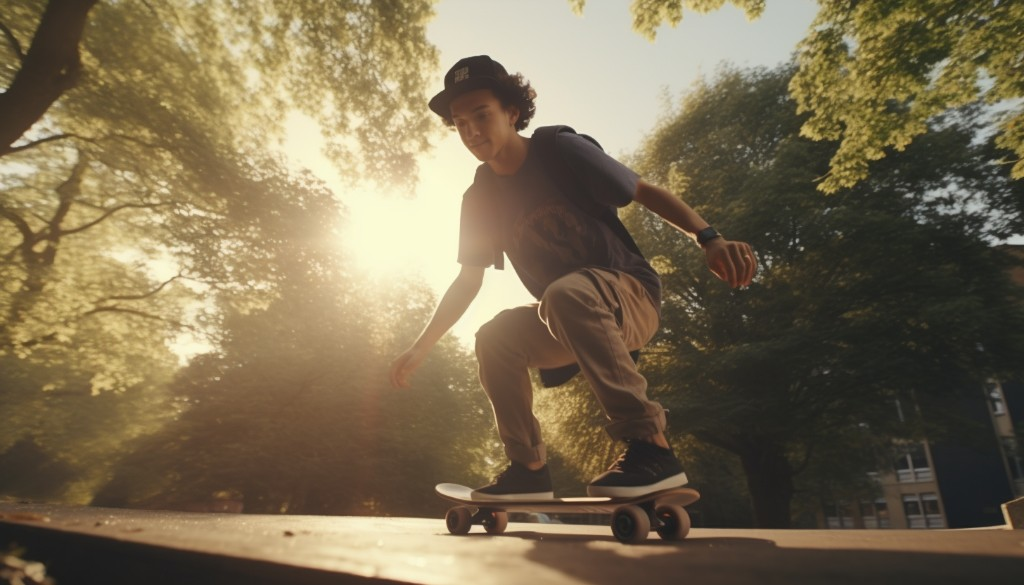
Can Beginners Start with Electric Skateboarding?
There’s a common misconception that electric skateboarding is strictly for experienced riders. In reality, even beginners can start their journey with e-skateboards. It’s true that learning to ride an electric skateboard comes with its own set of challenges. The speed and power that make e-skateboards so exhilarating can also be intimidating for new riders.
However, these challenges should not deter beginners from taking up electric skateboarding. On the contrary, they provide opportunities for growth and skill development. Many modern e-skateboards come equipped with beginner-friendly features such as adjustable speed settings, allowing new riders to start slow and gradually increase their speed as they gain confidence and skill.
Tips for First-Time Riders
Embarking on your first ride can be nerve-wracking, but here are a few tips to help ease the process:
- Start Slow: Don’t rush to hit top speed on your first go. Begin with the lowest speed setting on your board and gradually increase as you become more comfortable.
- Choose a Safe Environment: For your initial rides, choose a flat, open space free from traffic and obstacles.
- Wear Protective Gear: Safety should always come first. Make sure you’re equipped with a helmet, knee pads, and elbow pads before hopping on your board.
Remember, the goal of riding an electric skateboard for the first time is not to master it immediately, but to get comfortable and familiar with how it works.
Practicing Riding an Electric Skateboard
As with any new skill, practice is essential when learning to ride an electric skateboard. Before you hit the streets, take some time to familiarize yourself with your board. Try standing on it, moving it back and forth, and getting a feel for its weight and balance.
Once you’re comfortable standing on your board, practice pushing off and stopping. It’s a good idea to start practicing in a flat, open area where there are no cars or pedestrians. As your skills progress, you can start incorporating turns and riding up and down gentle slopes.
Don’t forget that every riding experience is a learning opportunity. The more you practice, the better you’ll get. But remember to always keep safety in mind. Wear protective gear, stay aware of your surroundings, and don’t ride beyond your skill level.
Understanding Your Skateboard Stance
When it comes to mastering the art of riding an e-skateboard, understanding your stance is crucial. The way you stand on your board can greatly impact your balance and control.
Most riders fall into one of two categories: “regular” (left foot forward) or “goofy” (right foot forward). If you’re unsure of which stance suits you best, try sliding across a smooth surface in your socks. The foot you naturally put forward is likely your lead foot on the skateboard.
Once you’ve determined your stance, practice standing on your board in this position. Keep your feet shoulder-width apart and your knees slightly bent for optimal balance. Remember, comfort is key, so feel free to adjust your stance as needed until it feels right.
As you continue your journey into the world of electric skateboarding, you’ll find that perfecting your stance is just as important as learning to steer and brake. With a solid stance, you’ll be well on your way to becoming a confident and proficient rider.
With these tips and insights, you’re now better equipped to begin your electric skateboarding adventure. Remember, every pro was once a beginner. So take it one ride at a time, and most importantly, enjoy the ride!
Essential Safety Equipment for Electric Skateboard
Taking a spin on an e-skateboard can be an exhilarating experience. However, it’s essential to prioritize safety above all else. Just like a traditional skateboard, accidents can happen, and therefore, having the right safety gear in place is crucial.
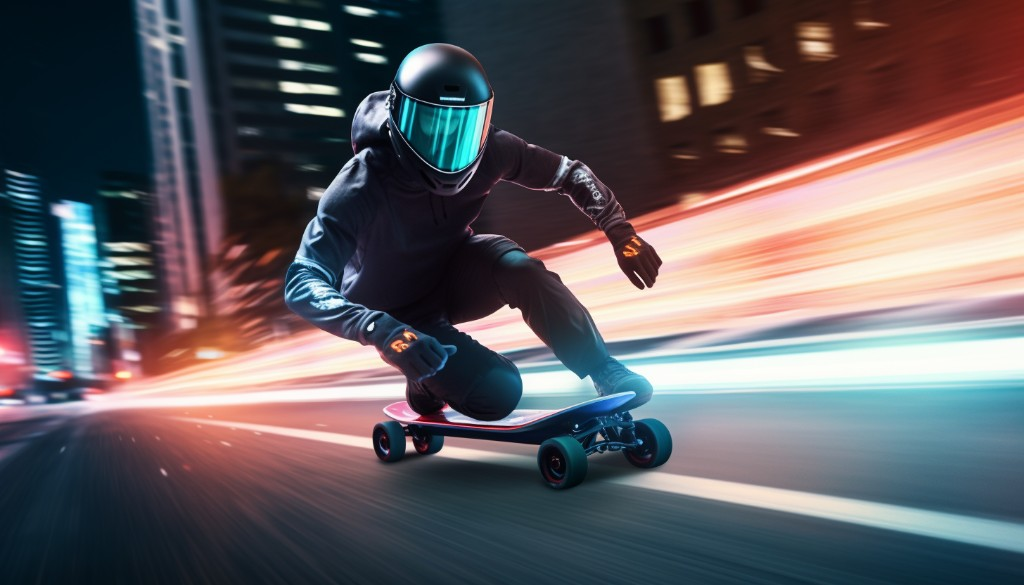
Importance of Safety Gear
Riding an e-skateboard without safety gear is like driving a car without a seatbelt—it’s just not a good idea. Protective gear minimizes the risk of injury in case of an accident. This includes minor spills that can lead to scrapes and bruises, or more serious accidents that could cause fractures or head injuries. Not only does safety gear protect you physically, but it also provides a sense of security that enhances your riding experience.
Helmet Selection
Choosing the right helmet is one of the most important aspects of safety gear for an electric skateboard. The helmet should fit snugly on your head without causing discomfort. Look for helmets specifically designed for skateboarding or extreme sports, as these have been tested for impacts similar to those you might experience on an e-skateboard. Also, make sure it has adequate ventilation to keep you cool during rides. Remember, helmet selection isn’t just about style — it’s about protecting your most valuable asset: your brain.
Body Pads and Sliding Gloves
Elbow pads and knee pads are other pieces of protective gear you shouldn’t overlook. These pads absorb shock and provide a barrier between your skin and the pavement, reducing the risk of scrapes and bruises in case of a fall. Sliding gloves, on the other hand, protect your hands and wrists when you’re performing slides or if you fall and instinctively put your hands out to break your fall.
Lights for Visibility
When you’re out and about on your e-skateboard, especially at night or during low-light conditions, lights for visibility are essential. They help motorists and pedestrians see you, reducing the chances of collisions. Consider installing lights on both the front and back of your e-skateboard. Additionally, wearing clothing or a backpack with reflective strips can also improve your visibility to others.
Appropriate Footwear
Last but not least, don’t forget about your feet. Appropriate footwear is crucial for a safe and comfortable riding experience. Your shoes should provide good grip to keep your feet firmly on the board. They should also have flat soles for stability and be made of durable material to protect your feet from any debris on the road. Avoid wearing flip-flops or other loose footwear that can easily slip off.
In the grand scheme of things, equipping yourself with the right safety gear can make a world of difference when it comes to electric skateboarding. It not only safeguards you from potential injuries but also boosts your confidence, making your rides more enjoyable and exciting. After all, the thrill of riding an e-skateboard comes with the peace of mind that you’re protected.
Utilizing Important Electric Skateboard Accessories
An electric skateboard is an exhilarating way to travel, offering speed, agility, and convenience. But, like any mode of transportation, it comes with its own unique set of needs. Among these are essential accessories that can enhance your riding experience and provide added safety. These include a backpack for carrying your essentials, an action camera for recording your rides, a spare battery for extended rides, a toolkit for maintenance, and a first aid kit for safety.
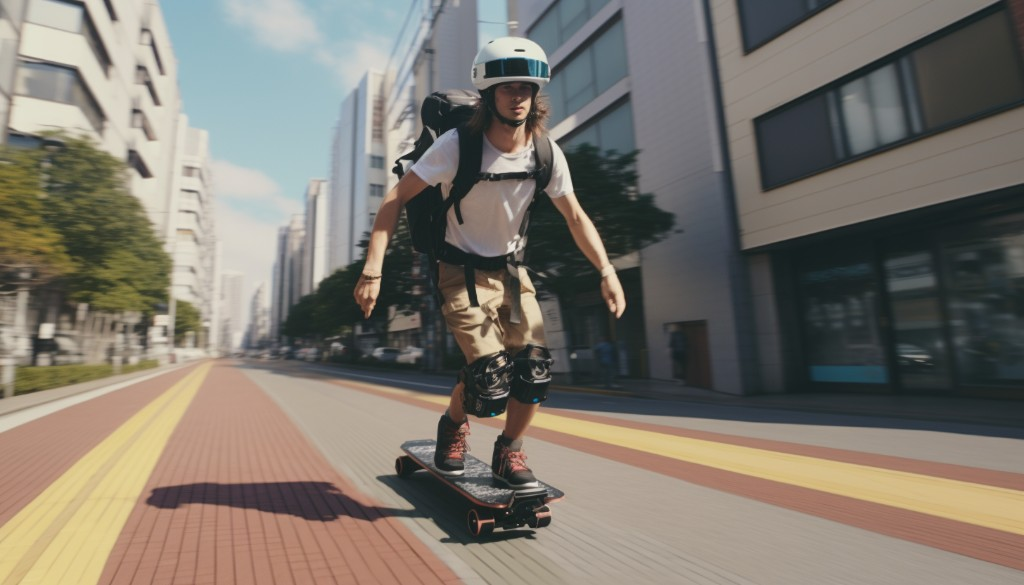
Backpack for Carrying Essentials
Imagine cruising on your electric skateboard, the wind in your hair and the sun on your face. Suddenly, you need to stop and search for your keys or phone. Not ideal, right? This is where a backpack comes in handy. It keeps all your essentials in one place, easily accessible when you need them. Plus, with the variety of designs available today, you can find one that not only serves its purpose but also complements your style.
Action Camera for Recording Rides
As a seasoned electric skateboard rider, I can tell you that some of the best moments happen when you least expect them. Whether it’s a stunning sunset as you cruise along the beachfront or an unexpected encounter with local wildlife, these are moments you’ll want to remember. An action camera lets you do just that. It’s durable, compact, and built to withstand high-speed movement and rough terrains, making it the perfect companion for your electric skateboard adventures.
Spare Battery for Extended Rides
There’s nothing quite like the freedom of cruising on an electric skateboard. But what happens when you’re in the middle of a ride and your battery dies? You’re stuck, right? Not if you have a spare battery for extended rides. This accessory is a game-changer, allowing you to double your ride time without having to stop and recharge. Just swap out the depleted electric skateboard battery for the fully charged one, and you’re good to go!
Tool Kit for Maintenance
Just like any vehicle, an electric skateboard needs regular maintenance to keep it in top condition. A toolkit for maintenance is essential, allowing you to tighten loose bolts, adjust your trucks, or even replace worn-out parts on the fly. It’s like having your own personal pit crew with you wherever you go. Trust me, it can be the difference between a smooth ride and a frustrating breakdown.
First Aid Kit for Safety
As much as we all love the thrill of riding an electric skateboard, it’s important to remember that accidents can happen. Whether it’s a minor scrape or a more serious injury, having a first aid kit for safety is a must. It’s not just about band-aids and antiseptic wipes; a good first aid kit should also include items like a compression bandage for sprains and a tourniquet for more severe injuries. Remember, safety gear isn’t just about preventing accidents—it’s also about being prepared when they happen.
As you can see, these accessories are not just add-ons—they’re essential components that can significantly enhance your electric skateboard experience. So, whether you’re a seasoned rider or a newbie, make sure you’re equipped with these essentials before hitting the road.
Understanding Your Electric Skateboard’s Controls
Imagine, for a moment, that you’re a spaceship commander. The electric skateboard is your spacecraft, and the remote control is your spaceship’s command center. Sounds thrilling, right? But as the commander, you need to know your command center inside and out. Let’s dive into the nitty-gritty of how to get comfortable with your e-skateboard’s controls.
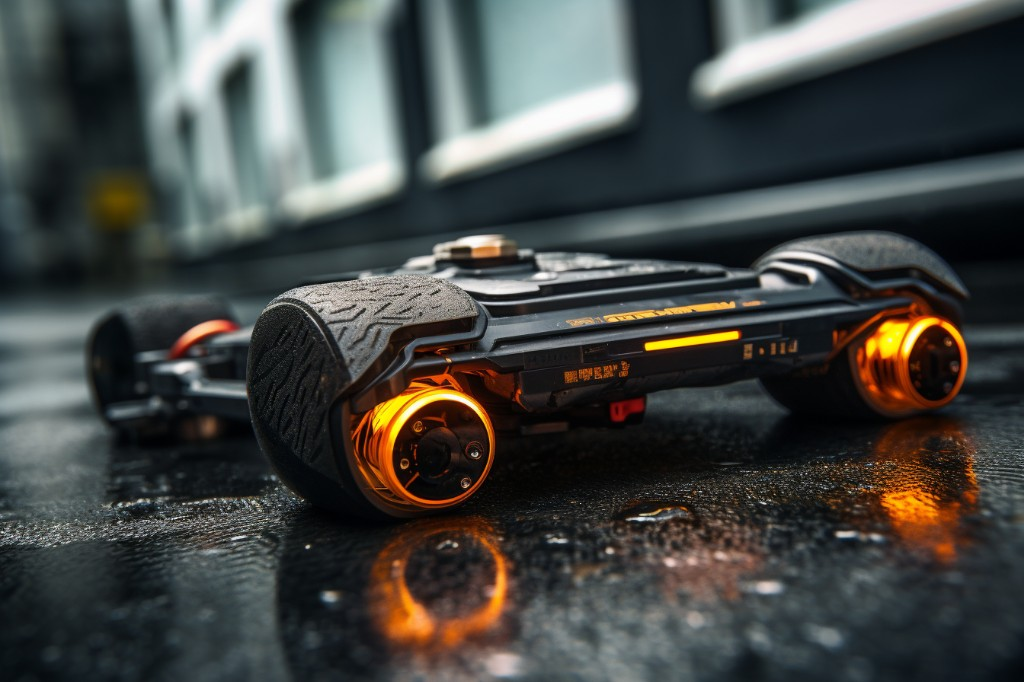
Familiarizing with the Remote Control
The first step in mastering your electric skateboard is getting comfortable with the remote control. The remote control is the lifeline between you and your board. With a simple flick of a switch or turn of a dial, you can control your speed, change direction, and even brake.
Most e-skateboard remote controls are handheld devices with a throttle for controlling speed and a switch for braking. Some also include LED lights to indicate battery life and connection status. The key here is practice. Spend time understanding how the throttle responds to your touch – is it sensitive or does it require a firm push? Understand how quickly your board reacts when you apply the brakes through the remote control.
Remember, every electric skateboard and its accompanying remote control may function slightly differently. Therefore, reading the user manual thoroughly can provide valuable insights into the specific features of your board’s remote control.
Setting Up Your Electric Skateboard
Now that you’ve gotten a handle on the remote control, let’s move onto setting up your electric skateboard for its first spin. First off, ensure that both your board and remote control are fully charged. Nothing ruins a maiden voyage like a dead battery halfway through!
Next, turn on the board and remote control. Some boards automatically enter pairing mode when switched on, while others might require you to press a button on the remote control. Consult your user manual to understand the pairing process for your specific electric skateboard.
Once paired, test the connection by slowly moving the throttle on the remote control. Your board should respond accordingly. If it doesn’t, refer to your user manual for troubleshooting steps or consider reaching out to the manufacturer’s customer service.
Learning to Brake and Turn
Mastering the art of braking and turning is crucial for a safe and enjoyable riding experience on your electric skateboard. For braking, it’s all about gradual application. A sudden brake can cause you to lose balance and fall. Practice applying the brakes gently at first, then gradually increase the pressure as you become more comfortable.
Turning on an e-skateboard is similar to turning on a traditional skateboard. It’s all about shifting your weight. Lean into the direction you want to turn and let your body weight guide the board. Start with wide, sweeping turns before attempting sharper ones. And remember, practice makes perfect!
Now that you’re equipped with the basics of understanding your electric skateboard’s controls, you’re one step closer to conquering the streets (or parks) with your new ride. In the next section, we’ll delve into advanced electric skateboarding techniques to help you elevate your riding skills even further. Stay tuned!
Advanced Electric Skateboarding Techniques
As you become more comfortable with your electric skateboard, you may start craving the thrill of pushing your skills to the next level. This typically involves learning advanced techniques such as kick pushing, fast riding, and even performing tricks. These techniques can significantly enhance your riding experience and make you feel like a pro.
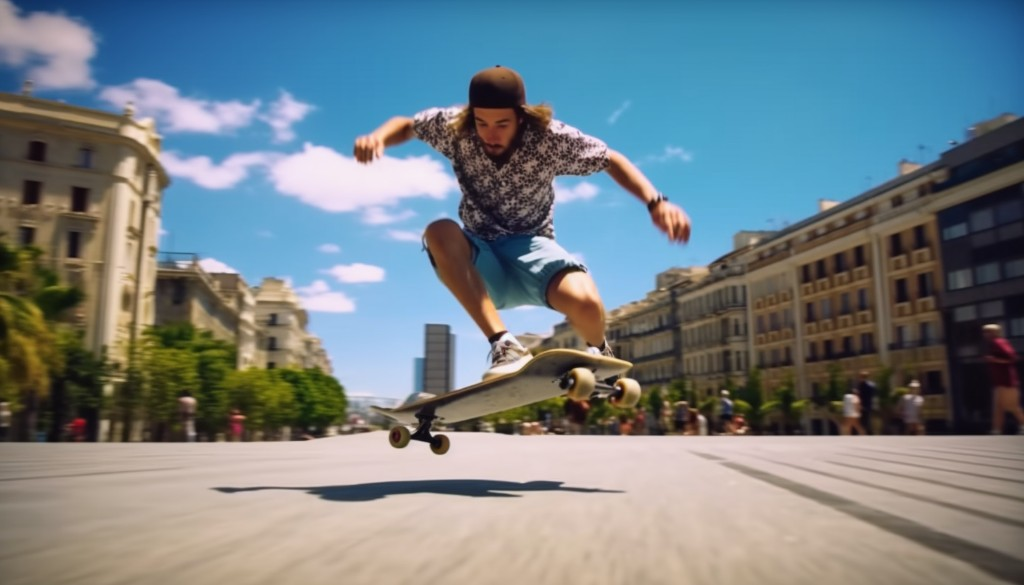
Learning to Kick Push
Kick pushing is a technique borrowed from traditional skateboarding where you propel the board forward by pushing off the ground with one foot while the other remains on the board. This technique is valuable for electric skateboard riders because it helps conserve battery life, provides a workout, and can be used when your board’s battery runs out.
To kick push on an electric skateboard, place your front foot across the board at about a 45-degree angle. Then, push off with your back foot while leaning slightly forward to maintain balance. Try to keep your movements smooth and steady. As you ride an electric skateboard using this method, you’ll find that it not only enhances your control over the board but also adds an extra dimension to your rides.
Mastering Fast Riding
Riding an electric skateboard at top speed can be exhilarating. But as your speed increases, so does the risk of accidents. Therefore, mastering fast riding involves learning how to maintain control at higher speeds while prioritizing safety.
Firstly, always wear protective gear. This includes a helmet, knee pads, elbow pads, and wrist guards. These will protect you in case of falls or collisions. Secondly, get comfortable with your board’s controls at lower speeds before gradually increasing to higher speeds. This gradual approach allows you to understand how your board behaves under different conditions.
Remember that maintaining balance is key when riding at top speed. Lean slightly forward to counteract the force pushing you backward. But be careful not to lean too far forward as this can make you lose control.
Lastly, always be mindful of your surroundings. At higher speeds, obstacles can appear quickly, and your reaction time is shortened. Therefore, keep your eyes on the road and be ready to react to unexpected situations.
Performing Tricks on an Electric Skateboard
Once you’ve mastered riding at top speed and kick pushing, you might want to try performing tricks on your electric skateboard. Doing tricks can take your riding experience to a whole new level and provide an adrenaline rush like no other.
Start with simple tricks like manuals, where you lift the front wheels off the ground and ride only on the back wheels. Or try carving, which involves making S-shaped patterns as you ride. These basic tricks can help build your confidence and balance before attempting more complex maneuvers.
As with all aspects of electric skateboarding, safety should be your top priority when learning tricks. Always wear protective gear, practice in a safe environment away from traffic and people, and don’t rush the learning process. Remember, even the most experienced riders took time to master their skills.
As you explore these advanced techniques, remember that the most important part is to have fun and enjoy the ride. After all, that’s what electric skateboarding is all about. Whether you’re kick pushing through a park, racing at top speed down an open road, or showing off your new tricks, each ride is a chance to experience the thrill of electric skateboarding.
Maintenance and Care of Your Electric Skateboard
It’s been a thrilling ride, mastering the advanced techniques on your electric skateboard, hasn’t it? But let’s not forget, like any high-performance machine, your e-skateboard also needs regular maintenance and care to keep it in top shape. From cleaning to replacing bearings and belts, to ensuring battery health, there’s a lot to be mindful of.
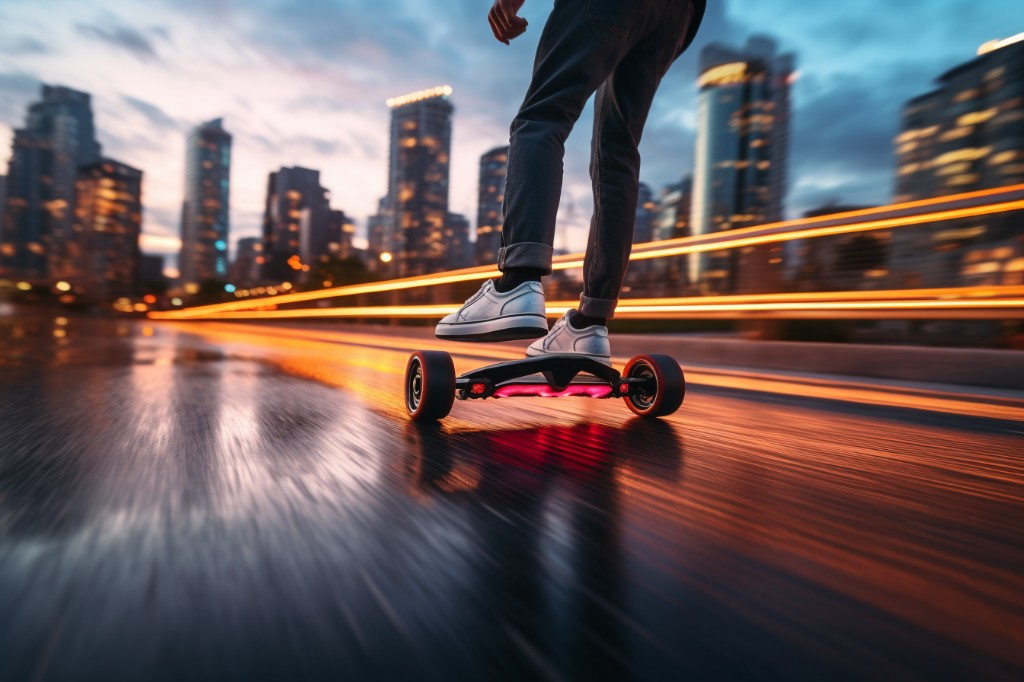
Cleaning Your Electric Skateboard
Imagine, if you will, your electric skateboard as a loyal horse from the wild west. It carries you over rough terrains, through the dust and grime, without a complaint. The least you can do is keep it clean, right?
How do you do that? Start with removing any visible dirt and debris from the deck, wheels, and trucks using a soft brush. Then wipe it down with a damp cloth. Be careful not to get any water in the motor or the battery compartment – they don’t play well with moisture.
And when should you clean your electric skateboard? Ideally, after every ride. But if that’s not feasible, aim for a thorough cleaning once every week or two, depending on how often and where you ride. Trust me, your board will thank you for it.
Replacing Bearings and Belts
Next up in the maintenance roster is replacing bearings and belts. If your e-skateboard has started making strange noises or if you feel it’s not as smooth as it used to be, it might be time to check these components.
The process of replacing bearings and belts on an electric skateboard is quite straightforward. For the bearings, start by removing the wheels. You’ll find two bearings per wheel – one on each side. Pop them out gently using a skate tool or a screwdriver, and replace them with the new ones.
When it comes to replacing belts, first remove the motor cover and loosen the motor mount. This will give you access to the belts. Swap the old belts with the new ones and ensure they’re properly tensioned before you reassemble everything.
Remember, the key here is patience and precision. You don’t want to rush things and end up damaging your beloved board.
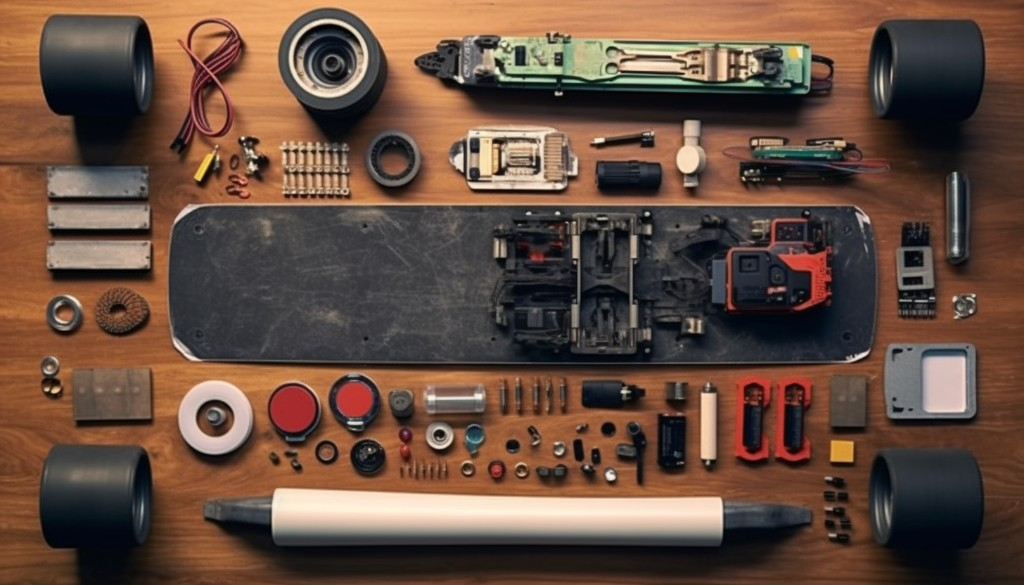
Ensuring Battery Health
Lastly, let’s talk about ensuring battery health. The battery is like the heart of your electric skateboard. If it fails, your board goes kaput. Therefore, it’s essential to maintain and extend its life as much as possible.
Here are some tips for that: First, try to keep your battery charged between 20% and 80%. This range is considered the ‘sweet spot’ for lithium-ion batteries and helps prolong their lifespan. Second, avoid exposing your board to extreme temperatures – both hot and cold – as it can harm the battery. And finally, if you’re not going to use your e-skateboard for a while, store it with around 50% charge. This prevents the battery from going into a deep discharge state, which can be damaging.
Taking care of your electric skateboard may seem like a lot of work, but believe me, it’s worth it. Not only does it enhance your ride quality, but it also saves you from expensive repairs down the line. And who knows, maybe it’ll even give you a few extra miles on your favorite route.
And with that, we’re ready to hit the streets again! But this time, we’ll also be delving into the legal aspects of e-skateboarding and how to commute safely with your board. Stay tuned!
Closing Thoughts
To reiterate, electric skateboarding not only provides a viable solution for commuting, but it also introduces an element of joy and adventure. Despite the legal aspects that need consideration, the benefits of using an electric skateboard for commuting are substantial. The sense of freedom one experiences while gliding through city streets is unparalleled. Remember, proper maintenance and care of your electric skateboard will ensure its longevity and your safety. Embrace the electrifying journey that awaits you!
Frequently Asked Questions
Is it legal to use electric skateboards for commuting?
Yes, it is legal to use electric skateboards for commuting in many areas. However, local laws can vary, so it’s important to check the regulations in your specific location.
What are the benefits of commuting using electric skateboards?
Commuting using electric skateboards is often faster than traditional methods in congested cities, and it also allows for greater flexibility and independence.
What are the challenges of commuting with an electric skateboard?
Challenges can include navigating through traffic safely, dealing with variable weather conditions, and ensuring the skateboard is adequately charged for your commute.
How does electric skateboarding provide a sense of freedom?
Electric skateboarding provides a sense of freedom by allowing you to move at your own pace, explore different routes, and enjoy the outdoors in a unique way.
How do I maintain and care for my electric skateboard?
Regular checks on the battery life, cleaning the board from any dirt or debris, and checking the wheels for any wear and tear are all important aspects of maintaining your electric skateboard.
